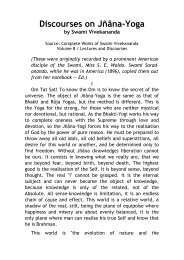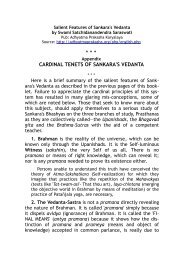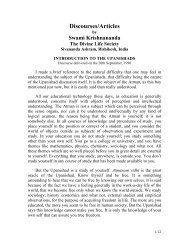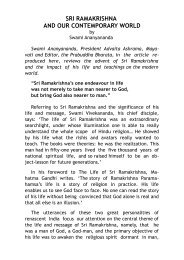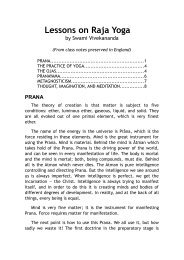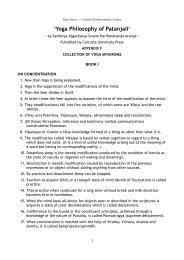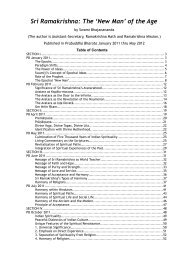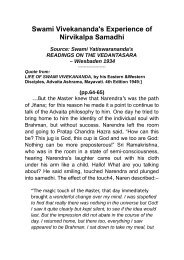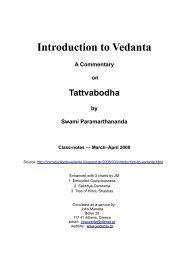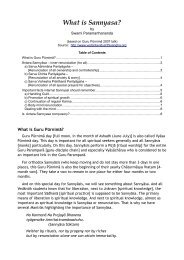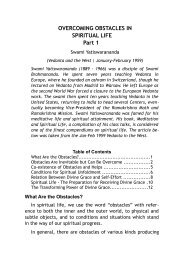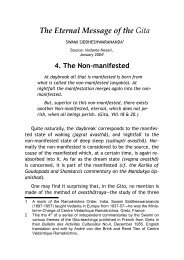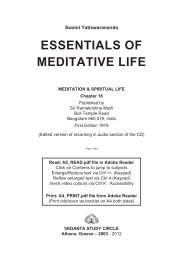Gita Summaries: Chapters 1-11 - Vedanta
Gita Summaries: Chapters 1-11 - Vedanta
Gita Summaries: Chapters 1-11 - Vedanta
You also want an ePaper? Increase the reach of your titles
YUMPU automatically turns print PDFs into web optimized ePapers that Google loves.
Swami Paramarthananda on <strong>Gita</strong> – <strong>Summaries</strong> of Chaps 1-<strong>11</strong><br />
b) Preparation for meditation:<br />
Physical preparation and Mental preparation:<br />
First choose a quieter or secluded place; that which is associated with spirituality. If you<br />
meditate in the dining room you will always have thoughts of food!!!<br />
Fix the asanam neither too high nor too low; neither too hard nor soft. The idea is that<br />
breathing must not be disturbed. The mind and prana are interconnected. Body should<br />
be relaxed and straight. Observe the breathing for a few moment and feel its<br />
smoothness and evenness. Then the sense-organs need to be taken care of; concentrate<br />
on the tip of the nose or in the middle of the eyebrows; the essence is that the eyes<br />
should be closed or half closed and withdrawn from the external world.<br />
Mental preparation: Even when the sense-organs the mind is capable of wandering away.<br />
You can concentrate the mind in one way: surrender all your thoughts at the feet of the<br />
Lord. We always worry about yoga schema; worry over past mistakes or future insecurity.<br />
The only thing we do efficiently all the time is worry, chitta!!! These twin rakshasas —<br />
past regrets and future anxiety— hijack our mind. The only remedy is “Surrender to the<br />
Lord”; Please forgive me for my past mistakes and Please give me strength to face the<br />
future. Now let me dwell on the present and meditate!!!<br />
c) Process of meditation:<br />
Meditation can be defined as a constant flow of similar thoughts centred on an object of<br />
meditation. The thoughts can change but they must be centred on the object of<br />
meditation; when unobstructed by dissimilar thoughts this is called Dhyanam. Meditation<br />
is definitely not blankness or empty or shunyam; meditation is a mental activity.<br />
There are 3 stages of meditation: i) Dharanam (focusing the mind on the object of<br />
meditation), ii) Dhyanam (maintenance or retention of the mind on the object of<br />
meditation) and iii) Samadhi (because of the above the mind is absorbed in the object of<br />
meditation and in time without effort the mind dwells there). Samadhi is not a<br />
mysterious state; we are all the time in samadhi; job worry, children’s worry, business<br />
worries etc. An absorbed mind is like the glass cover placed on a flame; it protects it<br />
from the wind. The fluttering flame becomes steady!!<br />
d) Object of Meditation:<br />
It can either be Saguna Ishwara; meditate on the Lord’s attributes and this is called<br />
Upasana Dhyanam. And if you are exposed to Shravanam and Mananam then meditate on<br />
Nirguna Brahman. Then a mysterious thing happens: the object becomes the subject<br />
itself. The subject-object division goes away. This is Brahman meditation or<br />
Nidhidhyasanam.<br />
e) Obstacles to Meditation:<br />
I) Dozing off/Nidra.<br />
Remedies for overcoming sleep during meditation: give sufficient rest to the body; don’t<br />
18



